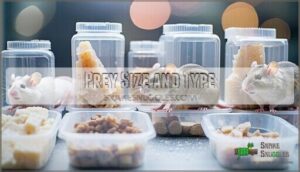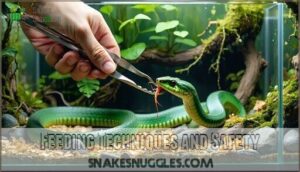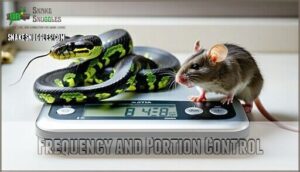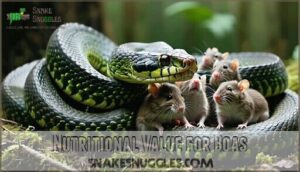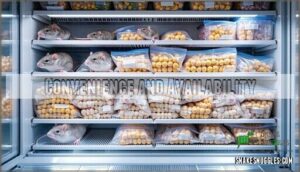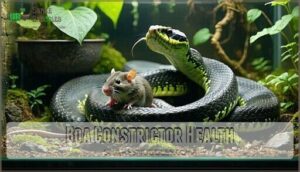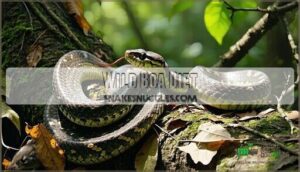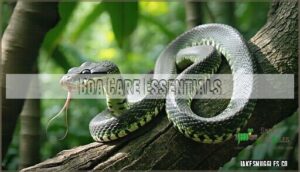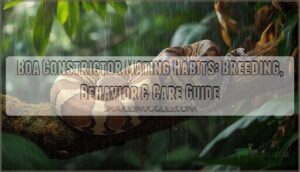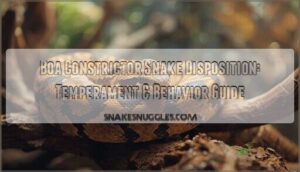This site is supported by our readers. We may earn a commission, at no cost to you, if you purchase through links.
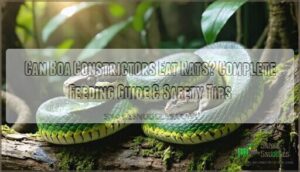
For pet boas, frozen-thawed rats are the gold standard because they’re safe, nutritious, and come in sizes perfect for your snake’s age and build. Rats provide the ideal protein and fat balance that keeps boas healthy and growing strong.
You’ll want to match the rat size to your boa’s girth – think of it as finding the right-sized sweater. Getting the feeding basics right involves more than just tossing a rat into the enclosure, though.
Table Of Contents
- Key Takeaways
- Boa Constrictor Diet
- Can Boas Eat Rats
- Boa Constrictor Feeding
- Rat Prey Benefits
- Boa Constrictor Health
- Wild Boa Diet
- Boa Care Essentials
- Frequently Asked Questions (FAQs)
- How big of a rat can my boa eat?
- Can my snake eat a rat?
- Do boa constrictors eat mice?
- How big of an animal can a boa constrictor eat?
- Do boa constrictors prefer live or frozen rats?
- How long can boas go without eating rats?
- What rat species are best for boa constrictors?
- Can baby boas eat adult rat pieces?
- Do boas need vitamin supplements with rats?
- Conclusion
Key Takeaways
- You’ll want to feed your boa frozen-thawed rats – they’re safer than live prey since they can’t bite or scratch your snake, plus they’re easier to store and handle.
- Match the rat size to your boa’s thickest body section – the prey shouldn’t be wider than your snake’s midsection to ensure safe swallowing and digestion.
- Adult boas eat every 2-3 weeks, while juveniles need weekly meals – overfeeding leads to obesity and health problems, so stick to proper scheduling based on your snake’s age.
- Rats provide perfect nutrition for boas – they contain 56-60% protein and balanced fat content that supports healthy growth without needing vitamin supplements.
Boa Constrictor Diet
You’ll find that boa constrictors are carnivorous snakes with straightforward dietary needs in captivity.
Their feeding routine centers around appropriately sized prey items like rats, rabbits, and other mammals, with careful attention to frequency and portion control, which is a key aspect of their dietary needs.
Feeding Practices in Captivity
Successfully feeding your boa constrictor in captivity requires following proven guidelines that prioritize safety and nutrition.
You’ll want to establish proper feeding practices from day one to guarantee your snake thrives.
Here are five essential feeding practices for captive boas:
- Choose frozen over live prey – Frozen rats eliminate injury risks and are easier to store
- Feed during evening hours – Match your boa’s natural nocturnal hunting schedule
- Use feeding tongs – Prevent accidental bites and avoid hand-feeding associations
- Provide fresh water daily – Large bowls support hydration and shedding needs
- Monitor feeding frequency – Juveniles eat weekly, adults every 2-4 weeks
Keeping a feeding log is vital for tracking your boa’s eating habits.
Prey Items and Frequency
Your boa constrictor’s feeding schedule depends on age and size. Young boas eat small rats weekly, while adults consume jumbo rats every 3-6 weeks.
A varied diet includes rats, rabbits, guinea pigs, and occasional chickens. Proper prey size shouldn’t exceed your snake’s widest point for safe consumption.
| Age Group | Prey Type | Feeding Frequency |
|---|---|---|
| Juvenile | Small rats/mice | Weekly |
| Adult | Jumbo rats (450-550g) | Every 3 weeks |
| Large Adult | Rabbits/guinea pigs | Every 6 weeks |
Food sourcing affects your budget—frozen suppliers like Kiezebrink offer bulk options, while pet shops provide convenience at higher costs. Frequency adjustments depend on your snake’s metabolism and breeding cycles.
Nutritional Considerations
You’ll want to understand rat nutrition for your boa’s health.
Rats provide balanced protein content that meets your snake’s nutritional needs without creating obesity risks when fed properly.
However, protein concerns arise with overfeeding – variety matters more than single-prey diets.
Food refusal happens naturally during breeding seasons.
Always verify water importance by providing fresh water, as proper hydration supports healthy digestion and overall animal nutrition.
Can Boas Eat Rats
Yes, boas can safely eat rats as their primary food source. Rats provide excellent nutritional value with balanced protein and fat content that supports healthy growth in captive boas.
You’ll find rats are the most common snake prey item, making them readily available from reptile suppliers. When choosing rat size matters – select prey that matches your boa’s midsection width.
Feeding live rats poses injury risks from bites and scratches, so opt for pre-killed or frozen options instead. Thawing frozen rats properly guarantees safe feeding while eliminating wild rat risks like parasites and diseases.
Your boa constrictor diet should center around rats, whether you’re feeding juveniles small rats or adults large ones. This rat consumption pattern mirrors their natural hunting behavior, where boas use constriction to subdue rodent prey.
Always source commercially-bred rats rather than wild-caught ones to prevent health complications and guarantee your snake receives proper boa constrictor food. A baby boa’s diet requires smaller, frequent meals to support their rapid growth, and it’s essential to provide proper boa constrictor food for optimal health.
Boa Constrictor Feeding
Feeding your boa constrictor properly requires understanding the right prey size, safe techniques, and appropriate timing.
You’ll need to match food size to your snake’s body width and establish a regular feeding schedule that prevents both underfeeding and obesity.
Prey Size and Type
Selecting the right prey size for your boa constrictor isn’t guesswork—it’s simple math.
Choose rats that match your snake’s thickest body section, creating only a slight bulge after feeding. Neonate boas start with fuzzy rats or small mice, while adults handle large rats comfortably.
Frozen vs live options both work, though frozen rats offer better safety. Food variety includes mice, rabbits, and chicks for nutritional balance.
They’re carnivorous generalists that capture prey through ambush, but are also vulnerable to avian and mammalian predators.
Feeding Techniques and Safety
When feeding your boa constrictor, always use prekilled or frozen-thawed rats rather than live prey to prevent injury from bites or scratches.
You can easily source prekilled rodents for boas online.
Use forceps for prey handling and feed in a separate container to avoid substrate ingestion during feeding sessions.
This approach guarantees safer boa constrictor feeding while reducing stress for both you and your snake.
Frequency and Portion Control
Creating a proper feeding schedule for your boa constrictor prevents obesity risks and maintains healthy metabolic rates.
Adult boas typically eat every 2-3 weeks, while juveniles need weekly meals.
Adjust portions based on your snake’s body condition – prey shouldn’t exceed the widest part of their midsection.
Monitor weight regularly since boa feeding habits vary individually, and overfeeding leads to serious health issues, which can be prevented by maintaining a proper schedule to avoid serious health issues.
Rat Prey Benefits
Rats offer excellent nutritional value for your boa constrictor, providing the perfect balance of protein and fat needed for healthy growth and metabolism.
You’ll find rats convenient to source from pet shops or frozen suppliers, making them a cost-effective staple that’s readily available year-round.
Nutritional Value for Boas
Rats pack serious nutritional punch for your boa’s health needs.
These rodents deliver exceptional protein content at 56-60%, far exceeding snakes’ minimum requirements while supporting muscle development and growth.
Here’s what makes rats nutritionally superior:
- Protein Content – Adult rats provide 59.7% protein on dry matter basis, perfect for snake nutrition
- Fat Balance – Contains 26.5% fat, meeting energy needs without excess weight gain
- Mineral Needs – Calcium-to-phosphorus ratio of 1.3-1.5 supports bone health perfectly
- Vitamin Intake – Essential nutrients support immune, cardiovascular, and neuromuscular systems effectively
This nutritional profile makes rats ideal protein sources for your boa’s dietary variety and long-term health maintenance.
Convenience and Availability
You’ll find rats everywhere from pet shops to specialized frozen food suppliers like Kiezebrink.
Pet shop prices can hit £6 per rabbit, making bulk purchasing from frozen suppliers your wallet-friendly move.
These sourcing options give you consistent access to properly prepared rodent diet staples, whether you need alternative prey or standard snake food for your captive diet plan.
Cost-Effective Option
When you’re smart about sourcing, rats become your wallet’s best friend for feeding boa constrictors.
Bulk buying frozen rats slashes costs substantially compared to individual purchases from pet stores.
- Bulk buying frozen rats reduces per-unit costs by 30-50% compared to single purchases
- Supermarket chickens offer occasional alternative prey at fraction of specialty supplier prices
- Breeding feeders yourself creates sustainable, cost-effective snake food supply long-term
- Reducing waste through proper storage and rotation maximizes your rodent diet investment
Maintaining proper humidity can prevent common shedding problems.
Boa Constrictor Health
Feeding your boa constrictor rats is generally safe, but you’ll need to monitor their health closely to prevent common issues.
Overfeeding can lead to obesity, while proper hydration and regular health checks guarantee your snake stays in peak condition.
Risks of Overfeeding
While rats offer excellent nutrition for your boa constrictor diet, overfeeding creates serious health risks.
Excessive feeding schedules lead to obesity concerns that dramatically impact your snake’s wellbeing and reduce lifespan by decades.
| Health Issue | Cause | Prevention |
|---|---|---|
| Organ Damage | Fatty liver disease from overfeeding | Feed every 2-3 weeks |
| Regurgitation Risks | Overwhelming digestive system | Proper prey sizing |
| Reduced Lifespan | Chronic metabolic stress | Monitor body condition |
Power feeding practices might seem beneficial, but they’re actually harmful.
Your boa’s organs weren’t designed for constant digestion – they need recovery time between meals for ideal snake nutrition balance.
Importance of Fresh Water
Fresh water isn’t just nice to have—it’s essential for your boa constrictor’s health.
Clean water supports hydration benefits, aids shedding, helps with temperature regulation, and enables proper waste elimination.
You’ll want to maintain excellent water quality by changing it regularly. Boa constrictors drink more than you might expect, especially during shedding cycles.
Think of water as your snake’s health insurance—without it, even the best rat-feeding schedule won’t keep your pet thriving.
Proper humidity is also key, as respiratory infections can arise from poor hygiene.
Regular Health Monitoring
You’ll want to keep a close eye on your boa’s overall health through regular monitoring.
Watch for weight management issues, shedding problems, and behavior changes that might signal trouble.
Check hydration levels by observing skin elasticity and fecal analysis can reveal digestive health.
Poor rat feeding practices can lead to malnutrition or stunted growth, making consistent boa constrictor care and snake health monitoring your best defense against issues like stunted growth.
Wild Boa Diet
Understanding a boa’s natural diet helps you make better feeding decisions for your pet.
In the wild, boas are opportunistic predators that actively hunt rodents, birds, and other small mammals using ambush tactics and their powerful constriction abilities, which is crucial for making informed decisions about their care, particularly regarding their natural diet.
Natural Prey and Hunting Tactics
In wild habitats, boa constrictors rely on Ambush Predation to capture rats and other Wild Rodents.
In the wild, boas are patient hunters that use stealth and power to control rodent populations naturally.
These patient hunters use their incredible Constriction Strength to subdue prey after striking from concealed positions.
Habitat Influence shapes their hunting strategies – boas position themselves along rodent trails or near water sources.
Their nocturnal Hunting Success depends on heat-sensing pits that detect warm-blooded prey in darkness, making rats easy targets.
Ecological Role in Rodent Control
You’ll find boas serve as nature’s pest control specialists in their ecosystems.
These powerful constrictors keep rat populations in check across natural habitats and urban environments alike.
Their presence creates ripple effects throughout the food chain, influencing predator-prey dynamics and maintaining ecological balance.
When boas reduce rodent numbers, they’re basically providing free pest control services that benefit entire communities and surrounding wildlife populations.
Adaptations for Large Prey Consumption
Boa constrictors are nature’s ultimate stretch machines. Their jaw flexibility allows them to unhinge their skulls, creating space for prey twice their head size.
Boa constrictors are nature’s ultimate stretch machines, unhinging their skulls to swallow prey twice their head size.
You’ll notice their constriction strength can exert 12 pounds of pressure per square inch, easily subduing rats. Their digestive efficiency breaks down bones and fur completely, while metabolic demands slow after large meals.
Proper boa nutrition is key to their overall health. Scalation adaptations help them grip struggling prey during feeding, utilizing their unique constriction strength.
Boa Care Essentials
Beyond feeding your boa properly, you’ll need to master essential care practices that keep your snake healthy and stress-free.
Creating the right environment and handling techniques makes all the difference between a thriving boa and one that struggles with health issues.
Proper Feeding and Handling
Now you’re ready to master the art of feeding your boa constrictor safely. Proper handling techniques and feeding guidelines prevent accidents and keep your snake healthy.
Here’s your safe feeding checklist:
- Thaw frozen-thawed rats completely – Use warm water, never microwaves, to prevent hot spots that burn your snake’s mouth
- Follow a consistent feeding schedule – Adult boas eat every 2-3 weeks, while juveniles need weekly meals
- Practice strict hygiene – Wash hands before and after handling prey to avoid scent confusion and bacterial transfer
- Use feeding tongs for safety – Keep your hands away from striking distance and prevent accidental bites during feeding
Never handle your boa for 48 hours after feeding to prevent regurgitation. Feed in a separate container to avoid substrate ingestion and reduce cage aggression.
Enclosure and Substrate Considerations
Your enclosure size should match your boa’s adult length—typically 6-8 feet long for most species.
Choose substrate types like cypress mulch or paper towels that won’t cause impaction if ingested.
Install heating elements on one side to create a temperature gradient, and maintain humidity control between 50-60%.
Selecting the right boa habitat products is essential for their well-being. Regular cleaning protocols prevent bacterial growth and keep your boa healthy in their reptile care environment.
Stress Reduction and Health Maintenance
Post-feeding stress disrupts your boa’s natural rhythm, but proper handling techniques can restore harmony. Wait 24-48 hours before any interaction to prevent regurgitation.
Monitor for shedding issues and maintain proper hydration methods through misting and water bowls. Proper hydration also requires the right snake water containers.
Quarantine protocols help isolate sick snakes from your collection. Enclosure enrichment with hiding spots reduces anxiety.
Watch for feeding behavior changes that signal underlying stress in boa constrictors.
Frequently Asked Questions (FAQs)
How big of a rat can my boa eat?
Your boa can safely eat rats that match the widest part of its midsection.
Think of it like a snake-sized sandwich – if the rat’s too chunky, it’ll cause problems.
Measure your boa’s thickest point for the perfect fit.
Can my snake eat a rat?
A bird in the hand is worth two in the bush.
Your snake can absolutely eat rats!
They’re actually the perfect staple food for boas, providing balanced nutrition and protein your snake needs to thrive.
Do boa constrictors eat mice?
Yes, boa constrictors can eat mice, though they’re typically starter prey for younger boas. Adult boas usually graduate to larger prey like rats, rabbits, or guinea pigs for proper nutrition.
How big of an animal can a boa constrictor eat?
Ever wondered about your boa’s dining capacity?
Your boa constrictor can eat prey roughly matching its body’s thickest diameter.
They’ll consume rats, rabbits, guinea pigs, or chickens depending on their size and age.
Do boa constrictors prefer live or frozen rats?
Frozen-thawed rats are safer and more convenient for your boa than live prey. Live rats can injure your snake through bites or scratches, while frozen options eliminate this risk completely.
How long can boas go without eating rats?
You’d be surprised—adult boas can skip meals for a month or more, especially if they’re healthy and not stressed.
Younger snakes need food more often, but adults handle fasting like pros.
No need to worry!
What rat species are best for boa constrictors?
Don’t worry about fancy rat breeds—common lab rats (Rattus norvegicus) are your best bet.
They’re safe, nutritious, and easy to find.
Stick with feeder rats from reputable suppliers, and avoid wild or pet store rats.
Can baby boas eat adult rat pieces?
You shouldn’t feed adult rat pieces to baby boas.
Cut-up prey can cause choking hazards and digestive issues.
Baby boas need appropriately sized whole prey like pinkie mice or small rats that match their body diameter for safe swallowing, to avoid digestive issues.
Do boas need vitamin supplements with rats?
Wild rats naturally provide 100% of boas’ nutritional needs, so you don’t need vitamin supplements when feeding whole rats.
The prey’s organs and tissues contain all essential vitamins and minerals your boa requires for healthy growth and metabolism.
Conclusion
Feeding your boa properly is like conducting a well-orchestrated symphony – every element must work in harmony.
Now you know that boa constrictors can eat rats safely and thrive on them.
Remember to choose appropriate prey sizes, maintain proper feeding schedules, and monitor your snake’s health regularly, providing ideal nutrition while keeping feeding sessions stress-free.
Your boa’s health depends on these consistent, thoughtful feeding practices.
- http://www.herpconbio.org/Volume_16/Issue_1/Reinert_etal_2021.pdf
- https://animals.howstuffworks.com/snakes/boa-constrictor.htm
- https://www.thecritterdepot.com/blogs/news/boa-constrictor-care-guide
- https://www.reddit.com/r/snakes/comments/sc4ol8/bci_feeder_size/
- https://www.animalsathome.ca/boa-constrictor-feeding-chart/


